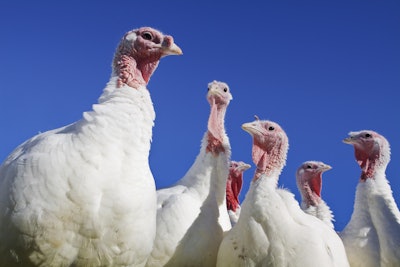
The U.S. turkey industry’s production slump stretched into a fourth year in 2021 as it faced abnormally high feed prices and weak demand.
According to WATT Global Media’s annual survey of U.S. poultry companies, the top U.S. turkey companies produced 6.824 billion pounds of live turkey in 2021. That’s 347 million fewer pounds, or 4.8%, less than the 7.171 billion pounds it produced in 2020.
In 2019, the industry produced 7.263 billion pounds. That makes another consecutive year of declining total production among the top 22 turkey companies. 2021 marked the fourth consecutive year-to-year decline in overall turkey production. From 2017 to 2021, production dropped by 609 million pounds.

Weak demand, flat prices
Dr. Thomas Elam, president of FarmEcon LLC, said between July 2020 and April 2021, feed costs increased exponentially for turkey, reaching peaks greater than 50 cents per pound on a ready-to-cook basis. Feed prices declined slightly at the end of 2021 but remained about 10 cents per pound higher than the prices producers paid for most of the previous five years.
At the same time, turkey parts prices have stayed nearly flat since January 2017. In 2021, chicken prices reached historic highs and prices for competing proteins like pork and beef were relatively high.
“The really bleak news is that the production cuts have not had any impact on parts prices,” Elam said. “We did see higher whole bird prices last year, but … that has not been enough to encourage producers to increase output.”
This indicates demand for turkey is weak. Market trends indicate retail and foodservice parts demand is shrinking, but not the holiday whole bird demand.
Based on early poult placement metrics, he predicts turkey production in early 2022 will be similar to last year.
“After that, 2022 production depends on whether or not profitability holds up,” Elam said. "If we can just equal 2021, that’s progress of a sort."
Jennie-O returns to top spot
Butterball and Jennie-O spent the past two decades trading places on the top spot of WATT PoultryUSA’s turkey rankings.
From 1991 to 1997, Butterball was the top company. In 1999, Jennie-O took the top spot and held it until 2006. Jennie-O was purchased by Hormel in 2001 and combined with the Turkey Store it's owned since 1986.
In 2006, Butterball was purchased by Smithfield and merged with Carolina Turkeys, becoming the largest turkey company and holding that position until 2021.
In 2021, Jennie-O Turkey Store eclipsed Butterball in production after it significantly cut its production between 2019 and 2021. Butterball’s production dipped by 244 million pounds of live turkey, or 18.7%, between 2019 and 2021.
Jennie-O and Butterball in 2021
In December 2020, Butterball announced it was scaling back some operations at its turkey processing plant in Carthage, Missouri. Soon after, it announced plans to spend $8.7 million at its turkey processing facilities in Ozark and Huntsville, Arkansas.
In February 2021, Hormel Foods Chief Financial Officer Jim Sheehan said Jennie-O was planning a transition to a more soybean-based formula, rather than corn, to offset the impact of high feed prices. Additionally, Hormel Chairman and Chief Executive Officer Jim Snee said Jennie-O would proactively raise prices to offset grain costs.
In May 2021, Sheehan said Jennie-O made record sales in the first half of the year and expected to close the year with better sales than the beginning of the pandemic. Also in May, Seaboard Corp. – Butterball’s 50% owner – reported it lost $4 million on its investment in Butterball in the first quarter of 2021, compared to the $14 million it lost during the same quarter in 2020. Sales were up during that period, but higher prices and decreased value-added sales led to lower margins.
In August 2021, Seaboard reported it lost $4 million on its investment in Butterball during the second quarter of 2021, which was less than the $14 million it lost during the same period in 2020.
In November 2021, Seaboard reported it lost $5 million on its investment in Butterball during the third quarter of 2021, compared to the $14 million it lost during the same period in 2020. At that time, it predicted the segment would become profitable for the rest of 2021 due to the holiday sales season.
In December 2021, Hormel announced plans to close a Jennie-O plant in Willmar, Minnesota, to make the business more efficient. At the same time, Snee said Jennie-O’s financial results didn't meet its own expectations
“The business has underperformed in recent years, and that’s not through a lack of effort on our team’s part,” Snee said. “That’s dealing with a significant oversupply situation that’s created a lot of volatility for us.”
In 2021, the strong performance of consumer products like ground turkey were a positive for the company. With the changes in plant operations, as well as a stronger focus on branded products, Snee said the company will be more consumer-driven going forward.

Jennie-O Turkey Store plant to close in Willmar, Minnesota: www.WATTAgNet.com/articles/44118


















